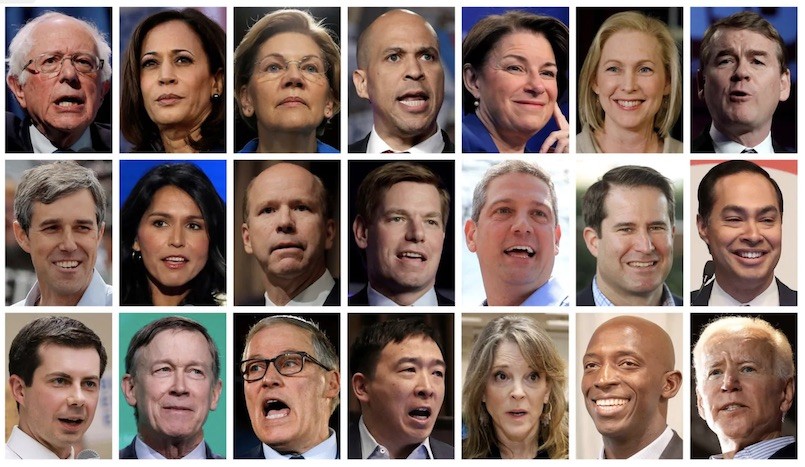While recently in the US it was announced that the Democratic Party was potentially increasing the number of Presidential candidates from the 24 declared candidates. At the same time I read this article in The Conversation about how many Americans are likely wondering how the party will ultimately make up its mind and settle on the best candidate, and I wondered if the same applies to agency search?
You often read in the trade media of pitches where there are 12 or more agencies invited to ‘pitch’ for an advertiser account. If like the Democratic Presidential Candidates the more candidates make it less likely to find the best candidate, is it the same when searching for an agency.
If Democrats appear to be having difficulty making up their collective mind this election season, it is possible that this apparent indecision is because there is no well-defined will of the people to be discerned at all. Perhaps the same applies for those pitches, which drag on forever as the client tries to make up their mind from too many candidate agencies?
The Math
From The Conversation article they used the example of 3 friends and a pollster walk into a bar and discuss the upcoming election. The first friend thinks that candidate A is better than B, and that C is the worst of all. The next agrees that B is better than C, but she thinks that B and C are both better than A. The final friend partially agrees with both of them: He thinks C is the best candidate, followed by A, and then B.
The pollster cannot say which is the best candidate, since, for these voters, there is no best candidate! Their ranked preferences are inconsistent with each other.
This situation is an example of Condorcet’s paradox.
It was named for the French Enlightenment philosopher and mathematician Marie Jean Antoine Nicolas de Caritat, marquis of Condorcet, an advocate of democratic reforms who perished in 1794, a victim of the French Revolution.
So how does that impact the US Democratic Party and their 24 candidates?
The US Democrats
In the Presidential election there are only two candidates for the same office, and each voter can prefer one or the other. Barring a perfect tie, one candidate will end up with the most votes. Ignoring complications like the Electoral College or voter turnout, the election process provides a way to measure the “will of the people.”
To Condorcet, a winner is a candidate who would win a one-on-one election against any other candidate. But, a paradox arises when there is no candidate who wins all the head-to-head contests against all other opponents – which implies that voters’ ranked preferences contradict one another.
How likely is this Condorcet’s paradox to arise in practice? It depends on how many candidates there are, and how evenly distributed the voters’ preferences are.
But the possibility is not as abstract as it may seem. For example, some Americans, including Bernie Sanders , believe that, had Sanders won the Democratic primary against Clinton in 2016, he would have beaten Trump in the general election. This implies an underlying rock/paper/scissors inconsistency: Trump beats Clinton; Clinton beats Sanders; but, somehow, Sanders beats Trump.
In a three-candidate race, there are six possible ways of ranking them. There is about a 9% chance the electorate, as a whole, has no clear preference.
With 24 different candidates running, there are 620 billion trillion possible rankings. The calculated probability that there is no Condorcet winner, or outright winner is 70% of the time.
So what does this mean for the advertising agency pitch process?
The Pitch
Our experience is that large marketing departments inside large organisations have a large number of stakeholders involved in making the decision on selecting advertising agencies, much like the electorate electing a political leader. But when you expend the scope from a single market to a regional or global market pitch, suddenly there is a multiple of stakeholders involved in selecting the one successful agency.
The other impact of large accounts is that multiple agencies will be competing to be in consideration, to put themselves forward as candidates. Without discipline it is very easy for big clients putting their account up for pitch to be inundated with candidate agencies, much like the Democratic Party is inundated with Presidential Candidates. But also the more stakeholders within the company the more people that will want to put forward their favourite agency as one of the candidates.
While I have never heard of a pitch with 24 candidate agencies, there have been examples of pitches with eight or ten or more agencies in consideration. So what does this mean for making a decision on the successful candidate? What is the chance that none of the successful agencies will be the ultimate winner based on a head-to-head contest?
Well if you have three candidate agencies there is an 8.8% chance of not finding an outright winner, while 9 agencies means there is a 45.5% chance of not finding a unanimous outcome, at 11 agencies it is better than a 50/50 chance of getting an ultimate winner.
Of course this depends on a large panel of people selecting candidates (like an electorate) and while this can happen, with as many as 30 or more stakeholders involved in a major pitch, locally, regionally or globally, not every stakeholder is equal and can lead to the preference of some of the stakeholders to be overridden by the preference of a few. The pitch process is not always a democratic one, even though multiple stakeholders will be involved.
What can we learn?
The Conversation article highlights that the Condorcet’s paradox assumes a worst-case scenario, where the candidates are statistically indistinguishable from one another. In this situation, each voter arrives at their rank order randomly and independently – as if each voter secretly rolls the dice to rank the candidates.
Likewise in pitches, the agencies have a chance to distinguish themselves from each other with the selection candidates. Therefore the larger the number of agencies under consideration and the larger the number of stakeholders responsible for selecting the winning agency the more likely Condorcet’s paradox applies and the less likely you are to arrive at an aligned and successful decision on a winner.
Therefore pitch management should try to apply a discipline to minimise the number of candidates in ultimate consideration and limit the number of selection stakeholders to ensure a more aligned and successful selection outcome.
Otherwise just as the Democrats appear to be having difficulty making up their collective mind this election season, it is possible that your pitch process will likewise result in a similarly difficult and unsatisfactory outcome.
TrinityP3’s comprehensive Search & Selection process provides extensive market knowledge, tightly defined process and detailed evaluation and assessment. Learn more here




